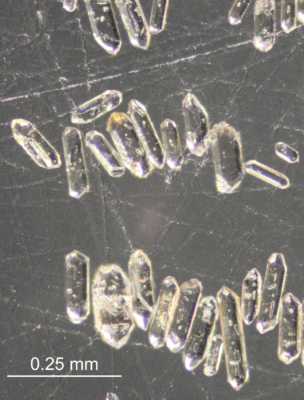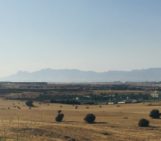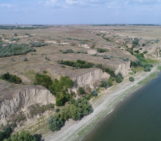
Name of proxy
detrital zircon geochronology
Type of record
provenance proxy
Paleoenvironment
any sedimentary environment in a geologically diverse and diagnostic area
Period of time investigated
any Period of the geological timescale of the Earth, during which sedimentary deposits were formed
How does it work?
Igneous rocks form through assemblages of minerals crystallising from melt. While major rock-forming minerals make up the bulk composition, accessory minerals represent a minor component in these rocks. However, they can give important information about the rock’s formation and origin. One of the most abundant accessory minerals in most rocks is zircon (ZrSiO4). Like all minerals, it is characterised by a specific crystal structure defined by its elements. The crystal structure of zircon readily incorporates uranium (U) on formation while excluding lead (Pb). This is exactly the reason why the formation age of zircon crystals can be determined using U decay series to Pb. By knowing the half-life of the U decay series and under the assumption that Pb in zircons forms solely due to radioactive decay after mineral crystallization, measuring the amount of the radiogenic stable Pb isotopes in zircons relative to the amount of their parent radioisotopes allows to determine the crystallization age of the mineral [1].
While the dating of zircons reveals the formation age of the zircon-bearing igneous rock (and potentially their metamorphic overprinting), zircon geochronology can also be applied to sedimentary deposits where it serves as a provenance analysis technique. Sediments and sedimentary rocks form through the erosion and redeposition of pre-existing rocks (e.g. igneous and metamorphic). During these processes, the original mineral assemblage often gets destroyed: minerals break down, alter, or get lost. Zircon is a highly resistant mineral and can survive processes of erosion, transport, and even temperature and pressure increase during metamorphism (and melting). Thus, zircons are often preserved and present as detrital minerals in sedimentary deposits. As the dating of detrital zircons reflects the formation age of the pre-existing rock, these ages can provide information about the proto-source of the sedimentary deposit and helps in reconstructing its origin and transport pathways. This provenance analysis is done through the visual comparison of detrital zircon age distributions of sediments and their potential source areas (Figure 1) and works best if the geology (i.e. the zircon ages) of the sediments’ hinterland is well known and multiple samples are available for comparison.

Figure 1. Example for the visual comparison of detrital zircon age distributions (in million years; Ma) of samples for provenance analysis via detecting similarities or differences in their zircon age populations (Plots Chiara Költringer).
Proceeding from here, how can we use the knowledge of sediment provenance that this proxy offers for the reconstruction of the climate of the past?
Sedimentary processes and climate are strongly connected and drive each other. While climate has control on sediment erosion, transport, and deposition, in reverse, it is also greatly influenced by the distribution of surface material and the formation of relief and topography. Understanding of how and where large masses of sediment are produced, which agents and pathways act for its transport (e.g. glaciers, rivers, wind, seas, gravitation), and where sedimentary sinks are formed, is crucial to the interpretation of climate, environment, and landscape evolution. Dependent on the analysed sediment (fluvial, marine, aeolian), the knowledge of its provenance can contribute to reconstruct e.g. river migration, sea-level dynamics, past atmospheric conditions, wind patterns, and dust dynamics.
What are the key findings from detrital zircon geochronology as a provenance tracer?
Detrital zircon geochronology, together with other single-grain approaches, has revolutionised the study of sediment provenance. In contrast to the analyses of bulk samples, single-grain provenance tracers are very source diagnostic and allow deciphering multiple contributing sources to one sediment deposit as the analyses of multiple individual grains can be traced back to single sources [2]. Due to its suitability for geochronology paired with its physical robustness, detrital zircon represents an ideal candidate for single-grain provenance techniques and has shown to be very powerful and widely applicable.
Recently, detrital zircon geochronology had a major break-through as climate-related provenance proxy for aeolian sediments and revealed the importance of multi-step transport for many aeolian deposits, namely loess. In this transport scheme, long-distance transport is carried out via rivers prior to wind deflation [e.g. 3]. These findings help in constraining the role of dust in the climate system and the importance of long- versus short-distance dust transport in the atmosphere, which both have specific climate forcing effects [4].
This post has been reviewed by the editorial board.
References [1] Parrish, R., 2013. Encyclopedia of Scientific Dating Methods. Encycl. Sci. Dating Methods 1–16. https://doi.org/10.1007/978-94-007-6326-5 [2] Stevens, T., Palk, C., Carter, A., Lu, H., Clift, P.D., 2010. Assessing the provenance of loess and desert sediments in northern China using U-Pb dating and morphology of detrital zircons. Bull. Geol. Soc. Am. 122, 1331–1344. https://doi.org/10.1130/B30102.1 [3] Újvári, G., Varga, A., Ramos, F.C., Kovács, J., Németh, T., Stevens, T., 2012. Evaluating the use of clay mineralogy, Sr-Nd isotopes and zircon U-Pb ages in tracking dust provenance: An example from loess of the Carpathian Basin. Chem. Geol. 304–305, 83–96. https://doi.org/10.1016/j.chemgeo.2012.02.007 [4] Adebiyi, A.A., Kok, J.F., 2020. Climate models miss most of the coarse dust in the atmosphere. Sci. Adv. 6, 1–10. https://doi.org/10.1126/sciadv.aaz9507


